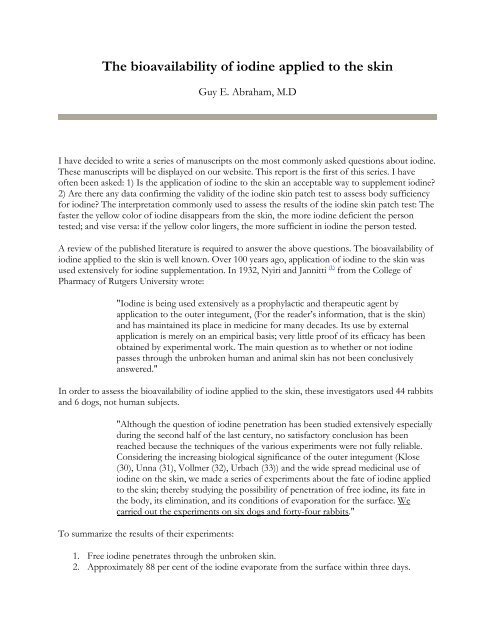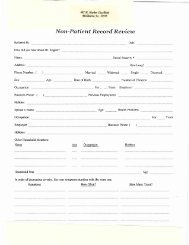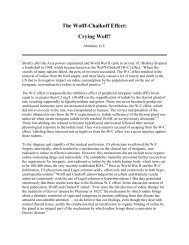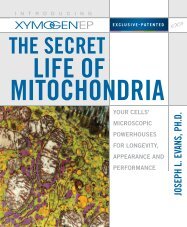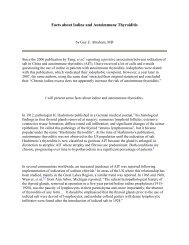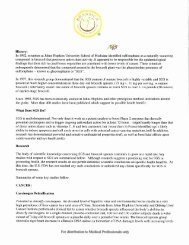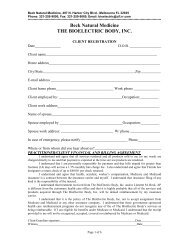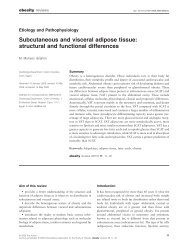The bioavailability of iodine applied to the skin - Beck Natural ...
The bioavailability of iodine applied to the skin - Beck Natural ...
The bioavailability of iodine applied to the skin - Beck Natural ...
You also want an ePaper? Increase the reach of your titles
YUMPU automatically turns print PDFs into web optimized ePapers that Google loves.
<strong>The</strong> <strong>bioavailability</strong> <strong>of</strong> <strong>iodine</strong> <strong>applied</strong> <strong>to</strong> <strong>the</strong> <strong>skin</strong><br />
Guy E. Abraham, M.D<br />
I have decided <strong>to</strong> write a series <strong>of</strong> manuscripts on <strong>the</strong> most commonly asked questions about <strong>iodine</strong>.<br />
<strong>The</strong>se manuscripts will be displayed on our website. This report is <strong>the</strong> first <strong>of</strong> this series. I have<br />
<strong>of</strong>ten been asked: 1) Is <strong>the</strong> application <strong>of</strong> <strong>iodine</strong> <strong>to</strong> <strong>the</strong> <strong>skin</strong> an acceptable way <strong>to</strong> supplement <strong>iodine</strong>?<br />
2) Are <strong>the</strong>re any data confirming <strong>the</strong> validity <strong>of</strong> <strong>the</strong> <strong>iodine</strong> <strong>skin</strong> patch test <strong>to</strong> assess body sufficiency<br />
for <strong>iodine</strong>? <strong>The</strong> interpretation commonly used <strong>to</strong> assess <strong>the</strong> results <strong>of</strong> <strong>the</strong> <strong>iodine</strong> <strong>skin</strong> patch test: <strong>The</strong><br />
faster <strong>the</strong> yellow color <strong>of</strong> <strong>iodine</strong> disappears from <strong>the</strong> <strong>skin</strong>, <strong>the</strong> more <strong>iodine</strong> deficient <strong>the</strong> person<br />
tested; and vise versa: if <strong>the</strong> yellow color lingers, <strong>the</strong> more sufficient in <strong>iodine</strong> <strong>the</strong> person tested.<br />
A review <strong>of</strong> <strong>the</strong> published literature is required <strong>to</strong> answer <strong>the</strong> above questions. <strong>The</strong> <strong>bioavailability</strong> <strong>of</strong><br />
<strong>iodine</strong> <strong>applied</strong> <strong>to</strong> <strong>the</strong> <strong>skin</strong> is well known. Over 100 years ago, application <strong>of</strong> <strong>iodine</strong> <strong>to</strong> <strong>the</strong> <strong>skin</strong> was<br />
used extensively for <strong>iodine</strong> supplementation. In 1932, Nyiri and Jannitti (1) from <strong>the</strong> College <strong>of</strong><br />
Pharmacy <strong>of</strong> Rutgers University wrote:<br />
"Iodine is being used extensively as a prophylactic and <strong>the</strong>rapeutic agent by<br />
application <strong>to</strong> <strong>the</strong> outer integument, (For <strong>the</strong> reader’s information, that is <strong>the</strong> <strong>skin</strong>)<br />
and has maintained its place in medicine for many decades. Its use by external<br />
application is merely on an empirical basis; very little pro<strong>of</strong> <strong>of</strong> its efficacy has been<br />
obtained by experimental work. <strong>The</strong> main question as <strong>to</strong> whe<strong>the</strong>r or not <strong>iodine</strong><br />
passes through <strong>the</strong> unbroken human and animal <strong>skin</strong> has not been conclusively<br />
answered."<br />
In order <strong>to</strong> assess <strong>the</strong> <strong>bioavailability</strong> <strong>of</strong> <strong>iodine</strong> <strong>applied</strong> <strong>to</strong> <strong>the</strong> <strong>skin</strong>, <strong>the</strong>se investiga<strong>to</strong>rs used 44 rabbits<br />
and 6 dogs, not human subjects.<br />
"Although <strong>the</strong> question <strong>of</strong> <strong>iodine</strong> penetration has been studied extensively especially<br />
during <strong>the</strong> second half <strong>of</strong> <strong>the</strong> last century, no satisfac<strong>to</strong>ry conclusion has been<br />
reached because <strong>the</strong> techniques <strong>of</strong> <strong>the</strong> various experiments were not fully reliable.<br />
Considering <strong>the</strong> increasing biological significance <strong>of</strong> <strong>the</strong> outer integument (Klose<br />
(30), Unna (31), Vollmer (32), Urbach (33)) and <strong>the</strong> wide spread medicinal use <strong>of</strong><br />
<strong>iodine</strong> on <strong>the</strong> <strong>skin</strong>, we made a series <strong>of</strong> experiments about <strong>the</strong> fate <strong>of</strong> <strong>iodine</strong> <strong>applied</strong><br />
<strong>to</strong> <strong>the</strong> <strong>skin</strong>; <strong>the</strong>reby studying <strong>the</strong> possibility <strong>of</strong> penetration <strong>of</strong> free <strong>iodine</strong>, its fate in<br />
<strong>the</strong> body, its elimination, and its conditions <strong>of</strong> evaporation for <strong>the</strong> surface. We<br />
carried out <strong>the</strong> experiments on six dogs and forty-four rabbits."<br />
To summarize <strong>the</strong> results <strong>of</strong> <strong>the</strong>ir experiments:<br />
1. Free <strong>iodine</strong> penetrates through <strong>the</strong> unbroken <strong>skin</strong>.<br />
2. Approximately 88 per cent <strong>of</strong> <strong>the</strong> <strong>iodine</strong> evaporate from <strong>the</strong> surface within three days.
3. Colloidal <strong>iodine</strong> evaporates somewhat more quickly than tincture <strong>of</strong> <strong>iodine</strong>; Lugol’s solution<br />
is more stable than ei<strong>the</strong>r <strong>of</strong> <strong>the</strong>m.<br />
4. <strong>The</strong> influence <strong>of</strong> ambient temperature on <strong>the</strong> evaporation <strong>of</strong> <strong>iodine</strong> is significant: within <strong>the</strong><br />
first minute, <strong>the</strong> losses <strong>of</strong> <strong>iodine</strong> by evaporation are: 10-15% at 9° c; 18-25% at 24° c; and<br />
35% at 37° c.<br />
5. <strong>The</strong> remaining <strong>iodine</strong> on <strong>the</strong> <strong>skin</strong> following evaporation <strong>of</strong> 88% <strong>of</strong> <strong>the</strong> <strong>to</strong>tal <strong>iodine</strong>,<br />
approximately 12 per cent, is at <strong>the</strong> disposal <strong>of</strong> <strong>the</strong> body, and penetrates through <strong>the</strong> <strong>skin</strong>.<br />
<strong>The</strong> <strong>bioavailability</strong> <strong>of</strong> <strong>the</strong> remaining 12% <strong>of</strong> <strong>the</strong> <strong>skin</strong> <strong>iodine</strong> is very gradual.<br />
6. <strong>The</strong> fate <strong>of</strong> <strong>iodine</strong> in all above experiments is <strong>the</strong> same whe<strong>the</strong>r <strong>iodine</strong> is <strong>applied</strong> <strong>to</strong> <strong>the</strong> <strong>skin</strong><br />
in <strong>the</strong> form <strong>of</strong> an alcoholic solution or in colloidal suspension. (For <strong>the</strong> reader’s information,<br />
<strong>the</strong> alcoholic solution is tincture <strong>of</strong> <strong>iodine</strong> and <strong>the</strong> colloidal suspension is a saturated aqueous<br />
solution <strong>of</strong> dia<strong>to</strong>mic <strong>iodine</strong>, I 2 ).<br />
<strong>The</strong> authors concluded (1) :<br />
"Our quantitative determinations prove that <strong>iodine</strong> which penetrates through <strong>the</strong><br />
<strong>skin</strong> is removed only slowly from within this area in<strong>to</strong> <strong>the</strong> body, thus forming an<br />
<strong>iodine</strong> depot in <strong>the</strong> <strong>skin</strong> for several days. In this prolonged retention <strong>of</strong> <strong>iodine</strong> within<br />
<strong>the</strong> <strong>skin</strong>, we see a favorable condition for a possible local prophylactic and<br />
<strong>the</strong>rapeutic action."<br />
<strong>The</strong> above conclusions apply <strong>to</strong> rabbits and dogs, but not <strong>to</strong> human subjects. <strong>The</strong> best study <strong>of</strong> <strong>the</strong><br />
<strong>bioavailability</strong> <strong>of</strong> <strong>iodine</strong> <strong>applied</strong> <strong>to</strong> <strong>the</strong> <strong>skin</strong> in normal human subjects was reported by Miller et al in<br />
1989 (2) . <strong>The</strong> purpose <strong>of</strong> Miller’s study was <strong>to</strong> assess <strong>the</strong> effectiveness <strong>of</strong> <strong>skin</strong> application <strong>of</strong> <strong>iodine</strong> in<br />
blocking radioiodide uptake by <strong>the</strong> thyroid gland. <strong>The</strong> subjects used in this study were 24 adult male<br />
volunteers aged from 21 <strong>to</strong> 51 years. <strong>The</strong>se subjects were divided in<strong>to</strong> 4 groups <strong>of</strong> 6 subjects each.<br />
One groups served as control and did not receive stable <strong>iodine</strong>. <strong>The</strong> o<strong>the</strong>r subjects in <strong>the</strong> remaining<br />
3 groups received respectively 130 mgm KI orally equivalent <strong>to</strong> approximately 100 mg iodide; 80 mg<br />
<strong>iodine</strong> (tincture) on <strong>the</strong> <strong>skin</strong>; and 160 mg <strong>iodine</strong> on <strong>the</strong> <strong>skin</strong>. All 24 subjects ingested 131 I labeled NaI<br />
and radioiodide thyroid uptake was measured at time 2 hr, 6 hr, and 24 hr post- ingestion <strong>of</strong><br />
radioactive iodide and stable <strong>iodine</strong>. Serum inorganic iodide levels were measured at time zero, 2 hr,<br />
6 hr and 24 hr post intervention. 24 hr radioiodide uptake by <strong>the</strong> thyroid gland as percent <strong>of</strong> dose<br />
administered was used <strong>to</strong> assess <strong>the</strong> effectiveness <strong>of</strong> <strong>iodine</strong> in blocking radioiodide uptake by <strong>the</strong><br />
thyroid. <strong>The</strong> 24 hr percent radioiodide uptake by <strong>the</strong> thyroid gland were: control: 10.9 ± 2.9 (SD)<br />
oral KI: 0.34 ± 0.26; <strong>skin</strong> 80 mg <strong>iodine</strong> = 7 ± 5.5%; and <strong>skin</strong> 160 mg <strong>iodine</strong> = 2.0 ± 2.5%. Prior <strong>to</strong><br />
administration <strong>of</strong> stable <strong>iodine</strong> <strong>the</strong> mean serum iodide in <strong>the</strong> 3 intervention groups were: 0.024<br />
mg/L; 0.033 mg/L; and 0.02 mg/L. <strong>The</strong> mean <strong>of</strong> <strong>the</strong> 3 mean values is 0.026 mg/L.
Under steady state conditions, <strong>the</strong> computed daily intake <strong>of</strong> <strong>iodine</strong> based on serum iodide is equal <strong>to</strong><br />
<strong>the</strong> product <strong>of</strong> serum iodide times 43.5 L/day, which is <strong>the</strong> renal clearance <strong>of</strong> iodide (3) . <strong>The</strong><br />
estimated average daily intake <strong>of</strong> <strong>iodine</strong> by this group <strong>of</strong> men is: 0.026 mg/L × 43.5 L/day = 1.13<br />
mg/day. This daily intake may be due <strong>to</strong> <strong>the</strong> iodization <strong>of</strong> bread in <strong>the</strong> 1960’s, 1970’s and in some<br />
states in <strong>the</strong> 1980’s. <strong>The</strong> estimated daily intake <strong>of</strong> <strong>iodine</strong> during that time in <strong>the</strong> U.S.A. was 1 mg (4) .<br />
This computed daily intake in Miller’s subjects is in agreement with <strong>the</strong> mean percent radioiodide<br />
uptake by <strong>the</strong> thyroid gland in this group <strong>of</strong> subjects with a mean <strong>of</strong> 10.9. By interpolation on Fig. 2<br />
<strong>of</strong> Reference 5, 10.9% uptake corresponds <strong>to</strong> an average intake <strong>of</strong> approximately 1.5 mg <strong>iodine</strong> (See<br />
Fig. 1).
<strong>The</strong> two questions mentioned previously can now be answered:<br />
I. Is <strong>the</strong> cutaneous route <strong>of</strong> <strong>iodine</strong> supplementation practical and effective?<br />
II. Does <strong>the</strong> <strong>skin</strong> <strong>iodine</strong> patch test give a reliable indication <strong>of</strong> whole body sufficiency for<br />
<strong>iodine</strong>?<br />
To answer <strong>the</strong> first question, we will use <strong>the</strong> data in <strong>the</strong> six subjects who were exposed <strong>to</strong> 160 mg<br />
<strong>iodine</strong> via cutaneous application, because <strong>the</strong> mean serum iodide levels were relatively constant over<br />
<strong>the</strong> 24 hr period: 0.27 mg/L at 2 hr; 0.2 mg/L at 6 hr and 0.24 mg/L at 24 hr post intervention. <strong>The</strong><br />
mean value <strong>of</strong> <strong>the</strong> 3 means is 0.24 mg/L iodide. <strong>The</strong> average amount <strong>of</strong> <strong>iodine</strong> bioavailable in <strong>the</strong>se<br />
6 subjects would be <strong>the</strong> product <strong>of</strong> <strong>the</strong> serum iodide levels by <strong>the</strong> renal clearance <strong>of</strong> iodide, that is<br />
43.5 L/day (3) . 0.24 mg iodide/L × 43.5 L/day = 10.4 mg. <strong>The</strong> percent <strong>of</strong> bioavailable <strong>iodine</strong> from<br />
160 mg <strong>applied</strong> <strong>to</strong> <strong>the</strong> <strong>skin</strong> is 10.4 x 100 / 160 = 6.5%. If <strong>the</strong> data reported by Nyiri and Jannitti 1 in<br />
dogs can be extrapolated <strong>to</strong> humans, that is 12% <strong>of</strong> <strong>the</strong> <strong>applied</strong> <strong>iodine</strong> was available for utilization by<br />
<strong>the</strong> body, with 88% evaporated; <strong>the</strong>n some 50% <strong>of</strong> <strong>the</strong> remaining <strong>skin</strong> depot <strong>of</strong> <strong>iodine</strong> was available<br />
during <strong>the</strong> first 24 hrs following <strong>skin</strong> exposure <strong>to</strong> <strong>iodine</strong>. One can conclude that <strong>skin</strong> application <strong>of</strong><br />
<strong>iodine</strong> is an effective if not efficient and practical way for supplementation <strong>of</strong> <strong>iodine</strong> with an<br />
expected <strong>bioavailability</strong> <strong>of</strong> 6 <strong>to</strong> 12% <strong>of</strong> <strong>the</strong> <strong>to</strong>tal <strong>iodine</strong> <strong>applied</strong> <strong>to</strong> <strong>the</strong> <strong>skin</strong>. <strong>The</strong> serum iodide levels<br />
were 10 times higher 2 hr post intervention with oral ingestion <strong>of</strong> 100 mg iodide than with 160 mg<br />
<strong>iodine</strong> <strong>applied</strong> <strong>to</strong> <strong>the</strong> <strong>skin</strong> (Fig. 2) .
From <strong>the</strong> published data, <strong>the</strong> <strong>skin</strong> <strong>iodine</strong> patch test is not a reliable method <strong>to</strong> assess whole body<br />
sufficiency for <strong>iodine</strong>. Many fac<strong>to</strong>rs play a role in <strong>the</strong> disappearance <strong>of</strong> <strong>the</strong> yellow color <strong>of</strong> <strong>iodine</strong><br />
from <strong>the</strong> surface <strong>of</strong> <strong>the</strong> <strong>skin</strong>. For example, if <strong>iodine</strong> is reduced <strong>to</strong> iodide by <strong>the</strong> <strong>skin</strong>, <strong>the</strong> yellow color<br />
<strong>of</strong> <strong>iodine</strong> will disappear because iodide is white. In order <strong>to</strong> regenerate <strong>iodine</strong> on <strong>the</strong> <strong>skin</strong>, one needs<br />
<strong>to</strong> apply an oxidant such as hydrogen peroxide, complicating <strong>the</strong> test fur<strong>the</strong>r. <strong>The</strong> evaporation <strong>of</strong><br />
<strong>iodine</strong> from <strong>the</strong> <strong>skin</strong> increases with increased ambient temperatures and decreased atmospheric<br />
pressure due <strong>to</strong> wea<strong>the</strong>r conditions and altitude. For example, <strong>the</strong> yellow color <strong>of</strong> <strong>iodine</strong> will<br />
disappear much faster in Denver, Colorado at 5,000 feet above sea level <strong>the</strong>n Los Angeles,<br />
California at sea level, irrespective <strong>of</strong> <strong>the</strong> amount <strong>of</strong> bioavailable <strong>iodine</strong>. <strong>The</strong> <strong>iodine</strong>/iodide loading<br />
test (4) is much more accurate and it is now available from two labora<strong>to</strong>ries:<br />
FFP Labora<strong>to</strong>ries<br />
80 Doc<strong>to</strong>rs Dr., Suite 3<br />
Hendersonville, NC 28292
Phone: 887-900-5556 / Fax: 828-684-3253<br />
Doc<strong>to</strong>r’s Data Inc.<br />
3755 Illinois Avenue<br />
St. Charles, IL 60174<br />
Phone: 800-323-2784 begin_<strong>of</strong>_<strong>the</strong>_skype_highlighting 800-<br />
323-2784 end_<strong>of</strong>_<strong>the</strong>_skype_highlighting / Fax: 630-587-7860<br />
References<br />
1. Nyiri, W., Jannitti, M., About <strong>the</strong> fate <strong>of</strong> free <strong>iodine</strong> upon application <strong>to</strong> <strong>the</strong> unbroken animal <strong>skin</strong>. An<br />
experimental study. J. Pharmacd. Exp. <strong>The</strong>r., 45:85-107, 1932.<br />
2. Miller, K.L., Coen, P.E., White, W.J., et al, Effectiveness <strong>of</strong> Skin Absorption <strong>of</strong> Tincture <strong>of</strong> I in<br />
Blocking Radio<strong>iodine</strong> from <strong>the</strong> Human Thyroid Gland. Health Physics, 56:911-914, 1989.<br />
3. Abraham, G.E.: <strong>The</strong> concept <strong>of</strong> orthoiodosupplementation and its clinical implications. <strong>The</strong> Original<br />
Internist, 11:29-38, 2004.<br />
4. Abraham, G.E., <strong>The</strong> safe and effective implementation <strong>of</strong> orthoiodosupplementation in medical practice.<br />
<strong>The</strong> Original Internist, 11:17-36, 2004.<br />
5. Abraham, G.E., Flechas, J.D., Hakala, J.C., Orthoiodosupplementation: Iodine sufficiency <strong>of</strong> <strong>the</strong> whole<br />
human body. <strong>The</strong> Original Internist, 9:30-41, 2002.


